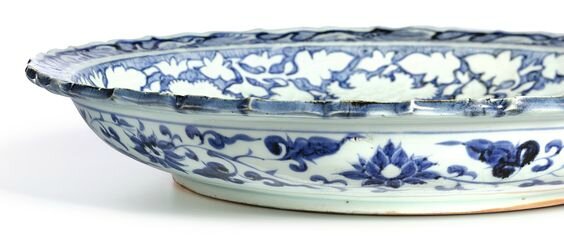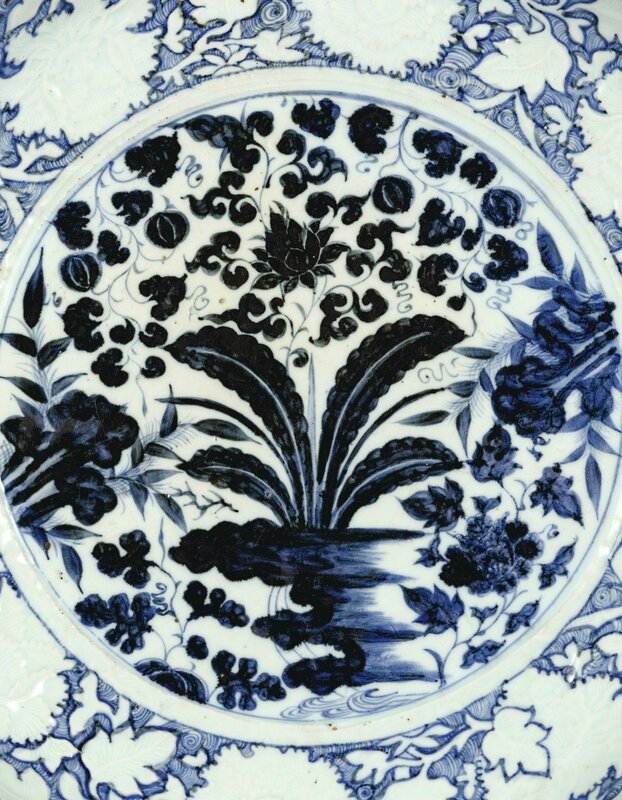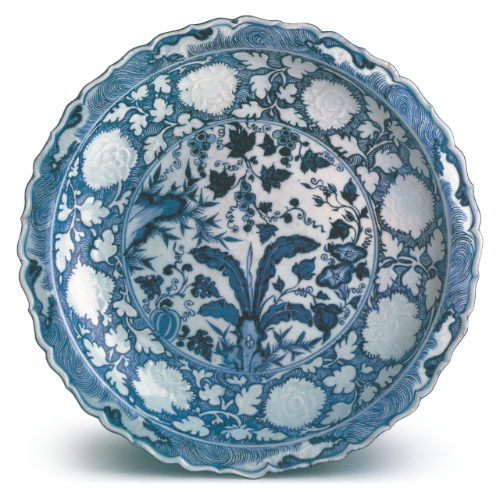A rare and important blue and white barbed 'banana plant and peony' charger, Yuan dynasty (1271–1368)
Lot 3636. A rare and important blue and white barbed 'banana plant and peony' charger, Yuan dynasty (1271–1368). Estimate 25,000,000 — 30,000,000 HKD. Sold 29,880,000 HKD (3,852,428 USD). Photo: Sotheby's.
sturdily potted with shallow rounded sides rising from a short foot to a wide everted bracket-lobed rim, the interior centred with a slightly sunken medallion boldly decorated in inky tones of cobalt blue with banana plant framed by a variety of fruiting and flowering branches, including curling leaves and globular melons borne on undulating stems, as well as large peony and lotus blooms, surrounded by a cavetto moulded in relief with blooming peony blossoms against a hatched ground, the barbed rim decorated with a band of crashing waves, the exterior bordered with a curling leafy lotus scroll, the unglazed base burnt orange in the firing; 48 cm, 18 7/8 in.
Collection of Commandant Paul-Louis Weiller (1893-1993).
Opulence in Blue and White
Regina Krahl
The blue-and-white chargers of the Yuan dynasty (1279-1368) are among the most impressive and characteristic porcelains of that innovative period. Those with designs moulded in relief and reserved in white on a washed or hatched blue ground are among the rarest and most elaborate creations of the Jingdezhen kilns. Their sheer size alone is outstanding; it had never been achieved by Chinese potters before the Yuan dynasty and was only rarely even attempted again thereafter. Although dishes such as the present piece are decorated with motifs from the classic repertoire of the period, those of barbed form, with moulded decoration reserved in white on blue, were individually conceived, each varying from the next. Their onerous production process and generous use of the expensive imported cobalt pigment severely limited the number of examples that could be produced in total, so that the potters soon switched to the manufacture of a simpler version, of circular form, without moulding, and with designs in blue on a white ground, which were better suited to serial production.
Moulded relief was practised at Jingdezhen already in the Song dynasty (960-1279), but only on monochrome white (qingbai) porcelains. The combination with underglaze cobalt-blue painting makes for an opulence otherwise rarely achieved in the ceramic medium. These porcelains were exported all over Asia and apparently managed even in India to overcome the prevailing prejudice against ceramics in general, which were believed to be unclean, which all ceramics not made in China indeed were. Surely the foremost attraction of Chinese porcelains all over Asia was their material superiority, with China having a monopoly on ceramics that were not only beautiful but also hard and dense and therefore remained clean and hygienic.
In addition to these advantages, the grandeur of these dishes was unmatched. Dishes of such substantial size were conceived for Middle Eastern eating and entertaining habits, where lavishly piled-up pilafs and other dishes, magnificently presented on such large platters would be offered at royal banquets. Their massive and powerful potting, with their thick, crisply moulded, bracket-lobed rim, has been dramatically emphasised by the outlining in cobalt blue of the barbed edge.
Finally, their quickly sketched central nature scenes, which are so unmistakably Chinese, evoking lush Southern gardens with fantastic rocks, bamboo, lotus, peonies and other plants, clearly played an equally big part in their success abroad. They would have been the perfect exotic goods for Middle Eastern merchants to sell back home to an amazed audience that had never seen anything like it before. The pleasant scenery is so universally agreeable that it still enchants us today as it did customers throughout Asia for centuries.
When the Jingdezhen kilns began to make massive chargers such as the present piece, Chinese porcelain entered a new era. Such porcelains represent the vanguard of an overarching change of taste in tableware that embraced all of Asia and influenced potters for centuries, although it was to take a while before China’s elite fully embraced Jingdezhen’s blue-and-white colour scheme itself.
A close comparison to the present piece is a dish in the Topkapi Saray Museum, Istanbul, from the Ottoman court collection (fig. 1), decorated with a similar garden scene in the centre, a moulded white peony scroll on a hatched ground around the well and a wave border on the rim. Although the central scene is similarly composed of melons, banana plant and rocks, it shows grapes in place of the lotus above, and a morning glory instead of the peony on the right (Regina Krahl, Chinese Ceramics in the Topkapi Saray Museum, Istanbul, ed. John Ayers, London, 1986, vol. 2, no. 561). A related dish in the Shanghai Museum (fig. 2) has a similar centre as the Istanbul dish, with the morning glory on the left, and the rim bears an aster or chrysanthemum scroll in white on blue (see the exhibition catalogue Youlan shencai. Yuandai qinghua ciqi teji/Splendors in Smalt. Art of Yuan Blue-and-white Porcelain, Shanghai Museum, Shanghai, 2012, cat. no. 27).
Blue and white barbed ‘banana plant and peony’ charger, Yuan dynasty, Ottoman court collection, Topkapi Saray Museum, Istanbul. After: Regina Krahl, Chinese Ceramics in the Topkapi Saray Museum, Istanbul, ed. John Ayers, London, 1986, vol. 2, no. 561.
Blue and white barbed ‘banana plant and peony’ charger, Yuan dynasty © Shanghai Museum
A fragment of a related charger, with peony, lotus and flowering branches in the centre and a moulded white peony scroll on a cross-hatched ground around the well was also among a large group of Yuan dynasty fragments of important dishes, bowls and jars recovered from the Red Sea (Kang Ruijun [Regina Krahl], ‘Xi Ya yu Nan Ya faxian de Yuan qinghua ciqi: Yi Hong Hai chenchuan wei zhongxin/Yuan Blue-and-White from West and South Asia, with Special Reference to the Red Sea’, Li Zhongmou et al., Youlan shencai. 2012 Shanghai Yuan qinghua guoji xueshu yantaohui lunwenji/Splendors in Smalt. Art of Yuan Blue-and-white Porcelain Proceedings, Shanghai, 2015, p. 200, fig. 14).
A similar dish with a phoenix among the garden plants in the centre, with a mixed flower scroll in white on blue on the rim, from the Safavid royal collection that was preserved in the Ardabil Shrine in Iran, is illustrated in John Alexander Pope,Chinese Porcelains from the Ardebil Shrine, Washington, D.C., 1956, pl. 22, together with three dishes of the simpler garden design, with circular rim, without moulding and no reserve decoration, pls. 12 and 13, one of them also included in the exhibition Yuan qinghua/Blue and White of the Yuan, Capital Museum, Beijing, 2009, catalogue pp. 126-7.
Another dish with a similar central garden motif is in the British Museum, London (fig. 3), from the collection of Robert C. Bruce, with the banana plant off-centre, surrounded by rocks, melon vines, morning glory and grapes, a relief-moulded white lotus scroll on a blue ground in the well, and similar waves on the rim (Jessica Harrison-Hall, Catalogue of Late Yuan and Ming Ceramics in the British Museum, London, 2001, cat. no. 1: 39).
Blue and white barbed ‘banana plant and lotus’ charger, Yuan dynasty © The Trustees of the British Museum
The present piece apparently once belonged to one of France’s most honoured army officers, Michel Ney (1769-1815), Field Marshal under Napoleon I, Duke of Elchingen, and Prince of Moskowa, whose name is among those inscribed on the Arc de Triomphe in Paris.
Sotheby's. Important Chinese Art, Hong Kong, 05 oct. 2016, 02:30 PM

/https%3A%2F%2Fprofilepics.canalblog.com%2Fprofilepics%2F1%2F0%2F100183.jpg)
/https%3A%2F%2Fstorage.canalblog.com%2F03%2F02%2F119589%2F96711876_o.jpg)
/https%3A%2F%2Fstorage.canalblog.com%2F11%2F31%2F119589%2F94773502_o.jpg)
/https%3A%2F%2Fstorage.canalblog.com%2F20%2F83%2F119589%2F94772815_o.jpg)
/https%3A%2F%2Fstorage.canalblog.com%2F26%2F72%2F119589%2F75604929_o.jpg)
/https%3A%2F%2Fstorage.canalblog.com%2F59%2F60%2F119589%2F26458628_o.jpg)










/image%2F1371349%2F20240416%2Fob_2a8420_437713933-1652609748842371-16764302136.jpg)
/image%2F1371349%2F20240414%2Fob_83ee65_2024-nyr-22642-0954-000-a-blue-and-whi.jpg)
/image%2F1371349%2F20240414%2Fob_15808c_2024-nyr-22642-0953-000-a-blue-and-whi.jpg)
/image%2F1371349%2F20240414%2Fob_e54295_2024-nyr-22642-0952-000-a-rare-blue-an.jpg)